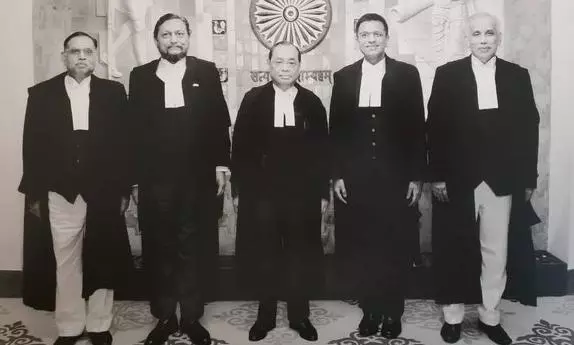
Explained | Who are the 5 judges who made Ayodhya Ram temple possible?
Ranjan Gogoi, SA Bobde, DY Chandrachud, Ashok Bhushan and S Abdul Nazeer ruled in 2019 in favour of the construction of a temple on the disputed site

The five judges of the Supreme Court who gave the historic verdict which made a grand temple for Hindu god Rama in Ayodhya possible have been invited to the January 22 consecration ceremony.
The invitees to the event, where Prime Minister Narendra Modi will be the chief guest, include over 50 jurists including former chief justices, lawyers, solicitor general Tushar Mehta and ex-attorney general KK Venugopal.
Key 2019 ruling
A five-judge bench of Ranjan Gogoi, SA Bobde, DY Chandrachud, Ashok Bhushan and S Abdul Nazeer ruled in 2019 in favour of the construction of a Lord Rama temple by a trust at a spot where the Babri mosque once stood.
The Ayodhya title dispute was between three parties: the Sunni Waqf Board, the Nirmohi Akhara and Ram Lalla Virajman. The judgment ended a legal dispute that had been raging since 1885.
What we know about the 5 judges
Ranjan Gogoi: Formerly chief justice of the Punjab and Haryana High Court, Gogoi was elevated to the Supreme Court in April 2012. He issued a contempt notice to retired Supreme Court judge Markandey Katju over his criticism of the court. He pulled up the government over the failure to appoint a Lokpal in 2017. He had a driving role in the compilation of the National Register of Citizens in Assam, his home state. Gogoi initially declined to take up the Ayodhya case as an urgent matter but did so when mediation efforts failed to yield results.
SA Bobde: A former chief justice of the Madhya Pradesh High Court, Bobde entered the apex court in April 2013. Along with justice Jasti Chelameswar, he put a hold on the government’s attempts to link public and private services with Aadhaar in 2015. He was one of the nine judges who unanimously affirmed that privacy was a fundamental right. He was also one of the three judges who suspended sales of firecrackers in Delhi due to concerns over the environment.
DY Chandrachud: Now the Chief Justice of India, he was elevated to the Supreme Court in 2016. Son former chief justice YV Chandrachud, his ruling in the right to privacy case in 2017 was widely acclaimed. He pulled up the police in Pune over the way the Bhima Koregaon case was handled. He also ruled in 2018 that there was no need to probe the death of judge Brijgopal Harkishan Loya, who died while hearing Amit Shah’s discharge application in a case of a fake encounter.
Ashok Bhushan: He practised from 1979 to 2001 at the Allahabad High Court and was elevated to the Supreme Court in May 2015 after being the chief justice of the Kerala High Court. He has figured in the cases related to the constitutionality of the Aadhar scheme and the Delhi versus Centre row.
Abdul Nazeer: A former judge of the Karnataka High Court, he was picked for the Supreme Court in January 2017. He is only the third judge to get into the apex court without having been the chief justice of a high court. He had argued for a five-judge bench to hear the Ayodhya case. He ruled in 2017 that the court could not pass a ruling on whether Triple Talaq was illegal but the case could be stayed for six months for parliament to pass a law to make it illegal. He was one of the nine judges who upheld the fundamental right to privacy.
